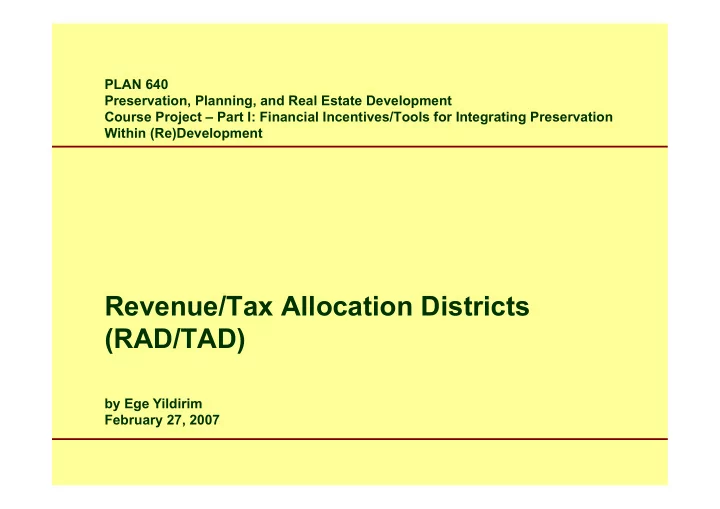

PLAN 640 Preservation, Planning, and Real Estate Development Course Project – Part I: Financial Incentives/Tools for Integrating Preservation Within (Re)Development Revenue/Tax Allocation Districts (RAD/TAD) by Ege Yildirim February 27, 2007
History and Brief Description of RAD / TADs “A defined area where tax monies gathered above a certain threshold for a certain period of time can be used directly for eligible improvements” Based on concept of tax increment financing ( TIF ) Idea that public investment in an area will increase property value, and generate additional tax revenue that would not have occurred otherwise Designed to channel funding toward improvements in distressed or underdeveloped areas ; captures future tax benefits of real estate improvements in a designated area to pay present cost of improvements; contributes to economic vitality of cities 1960s-70s, federal and state governments began cutting back economic development programs that could be used to revitalize communities. TIF has since become popular. TIF used since the 1950s; 49 states authorized with TIF legislation (exception Arizona). Widespread use in Illinois, Oregon, Missouri PLAN 640 - Course Project - Part I - RAD/TAD - Ege Yildirim - Feb. 27, 2007
History and Brief Description of RAD / TADs Main form of financing: bonds , backed by new taxes and/or revenues that result from the development, or other obligations RAD/TAD expands TIF by permitting municipalities to use other revenue sources beside tax increments: sales tax, parking fees or payments in lieu of taxes (PILOTs); special assessments; pledge of special assessment and/or payments in lieu of taxes PLAN 640 - Course Project - Part I - RAD/TAD - Ege Yildirim - Feb. 27, 2007
Sponsoring Entities and Administration State-level enabling legislation Illinois: 1977, Real Property Tax Increment Allocation Redevelopment Act Georgia: 1985, Georgia Code New Jersey: 2002, Redevelopment Area Bond Financing Law and Revenue Allocation District Financing Act Local implementation of legislation IL: 400 TIFs, 120 in Chicago NJ: 2005, Local Finance Board. The Office of Smart Growth coordinated with other state agencies. Many municipalities responded with plans (Milville, Fanwood, Maplewood, etc) GA: Westside, Hollowell - M.L. King, Stadium, Marietta State-level development agencies NJ Economic Development Authority (NJEDA) City agencies – initiating redevelopment area designation, redevelopment plans and projects PLAN 640 - Course Project - Part I - RAD/TAD - Ege Yildirim - Feb. 27, 2007
Beneficiary Projects and Parties Conditions of eligible areas ‘ But for ’ test: ‘ but for ’ the establishment of a RAD there would not be private investment ‘ Blight ’ ; underperformance in terms of social-economic vitality; high vacancy; low-income and education levels; low housing prices Projects funded Purchasing, leasing, condemnation, or acquisition of land; Relocation of displaced persons / businesses Demolition; new construction or rehabilitation Public facilities and infrastructure Affordable housing; conversions to single-family homes Mixed-use neighborhoods Soft costs for planning, engineering, financing, administration etc Time and financial ratio limits NJ: up to 15% of total taxable property within redevelopment area; 35- year maximum term of bonds Chicago: 23-year term of bonds (1984-2007) PLAN 640 - Course Project - Part I - RAD/TAD - Ege Yildirim - Feb. 27, 2007
Application – How It Works Establishment by municipality of revenue allocation / redevelopment plan and revenue allocation district NJ: Local Finance Board. Plans must identify eligible projects, estimated costs, construction schedule, bonding, assessment of impacts, etc Chicago: plan includes land assemblage; preservation of significant buildings; redevelopment agreements Approval of plan and of financial instrument NJ: Municipality and Local Finance Board Redevelopment Agreement between municipality and developer Issuance of bonds and loan to redeveloper - district agent (municipality, a county, regional development authority etc) issues bonds PLAN 640 - Course Project - Part I - RAD/TAD - Ege Yildirim - Feb. 27, 2007
Application – How It Works Existing tax base is frozen for continuing normal operations Any new tax increases/increments captured (up to 100 percent) and used by municipality for redevelopment work City may permit use of guarantees, deposits and other security by private developers Payments made over a period of time to coincide with debt service payments on bonds Excess revenue distributed to taxing districts within RAD PLAN 640 - Course Project - Part I - RAD/TAD - Ege Yildirim - Feb. 27, 2007
RAD/TAD vis a vis Preservation Not particularly used for preservation, but rather for downtown and neighborhood revitalization in general – residential, commercial, infrastructure development NJ ’ s Smart Growth initiative, Brownfields Some applications for preservation observed Chicago North Loop; Atlanta Beltline; Atlanta Historic Mableton Preservation And Improvement Plan Considerable potential for preservation, but on condition of profitable development to catalyse rehabilitation / preservation financing PLAN 640 - Course Project - Part I - RAD/TAD - Ege Yildirim - Feb. 27, 2007
RAD/TAD vis a vis Development Very friendly tool for development Provides greater incentives for redevelopment where private capital investment is otherwise deterred Gives municipalities more flexibility in the financing of local redevelopment projects Alternative to municipal bonds, reducing the risk to municipality by putting burden of upfront financing onto developer Creating tax base needed to provide neighborhood services without the burden of high residential tax rates Taxes for underlying real estate are not affected. PLAN 640 - Course Project - Part I - RAD/TAD - Ege Yildirim - Feb. 27, 2007
Success and Efficacy Commended as powerful tool , cited as only way to ensure effective public- private partnership to facilitate resurgence of areas by encouraging new substantial private investment Legislation is complicated PLAN 640 - Course Project - Part I - RAD/TAD - Ege Yildirim - Feb. 27, 2007
Recommend
More recommend